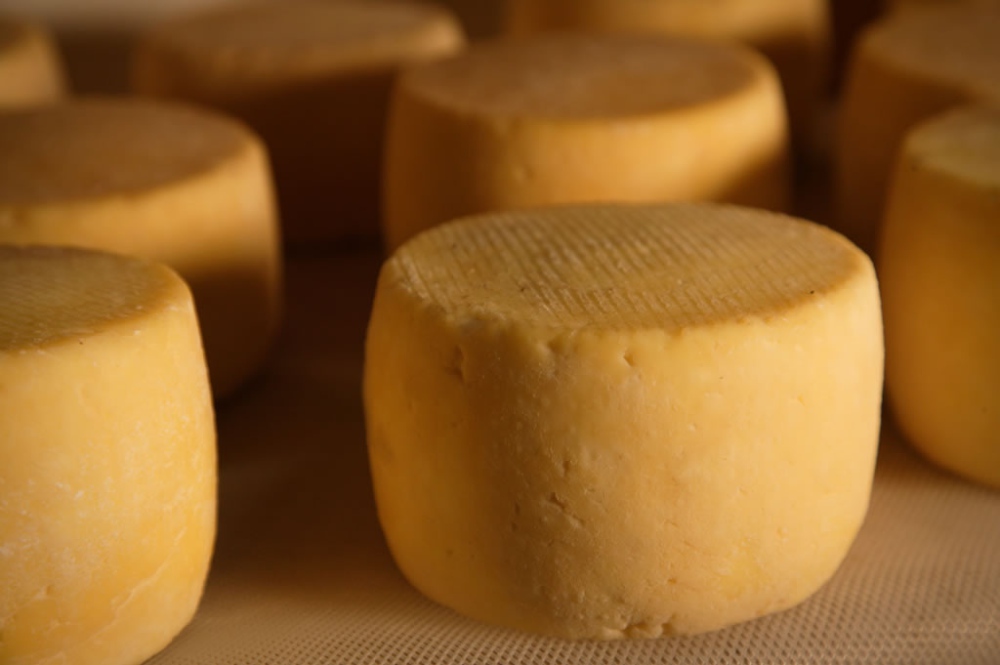PDO Tuscan Pecorino


An Italian cheese of excellence
Pecorino in Tuscany has very ancient origins dating back to Etruscan times. The first certain historical records of its production are found as early as Pliny the Elder, who attests to its presence in the area of Luni - the present Lunigiana.
Sheep farming and sheep breeding saw increasing development in the region: thus, the first cheese factories were born and there was a separation between the figure of the shepherd, the breeder of the sheep and that of the cheesemaker, the actual producer of the cheese.
Processing steps
PDO Tuscan Pecorino is made from whole sheep's milk in two varieties with the addition of calf rennet.
The paste undergoes cooking and breaking until curd granules are determined, varying in size from that of a grain of corn for the "semi-hard" type to that of a hazelnut for the "soft" type.
This is followed by pressing and salting, which is followed by an aging period of varying length depending on the gastronomic placement of the cheese.
PDO Tuscan Pecorino is made from whole sheep's milk in two varieties with the addition of calf rennet.
The paste undergoes cooking and breaking until curd granules are determined, varying in size from that of a grain of corn for the "semi-hard" type to that of a hazelnut for the "soft" type.
This is followed by pressing and salting, which is followed by an aging period of varying length depending on the gastronomic placement of the cheese.
Characteristics
The shape of the finished product is cylindrical with flat faces, varying in diameter from 15 to 22 cm; the heel is slightly convex, ranging in height from 7 to 11 cm and the weight of the forms varies from 1 to 3.5 kg.
The color of the rind is yellow with variable hue, but depending on the treatments undergone (tomato, ash, oil) it may also appear black or reddish. The paste is straw-white with a delicate flavor that is never spicy.
It is good practice to store Pecorino in a cool and dry environment. In the Tuscan tradition, it is kept completely immersed in extra virgin olive oil along with pepper and bay leaves: in order to maintain in this way its degree of seasoning, while the oil enhances its taste characteristics.
The shape of the finished product is cylindrical with flat faces, varying in diameter from 15 to 22 cm; the heel is slightly convex, ranging in height from 7 to 11 cm and the weight of the forms varies from 1 to 3.5 kg.
The color of the rind is yellow with variable hue, but depending on the treatments undergone (tomato, ash, oil) it may also appear black or reddish. The paste is straw-white with a delicate flavor that is never spicy.
It is good practice to store Pecorino in a cool and dry environment. In the Tuscan tradition, it is kept completely immersed in extra virgin olive oil along with pepper and bay leaves: in order to maintain in this way its degree of seasoning, while the oil enhances its taste characteristics.
Food and wine
The product can be eaten as a table cheese or grated, depending on the degree of seasoning.
Grated, it is used as a condiment for ribollita, for pasta and to flavor meat-based main courses.
Sliced, on the other hand, whether seasoned or fresh, it goes well with honey, jam, fruit and fresh seasonal vegetables.
It goes well with white wines, such as Bianco di Pitigliano or Monteregio Bianco, while with the seasoned one red wines, such as Morellino di Scansano, Chianti Classico, Montecucco Rosso or for seasoning longer than eight months Brunello di Montalcino.
Information: pecorinotoscanodop.it
The product can be eaten as a table cheese or grated, depending on the degree of seasoning.
Grated, it is used as a condiment for ribollita, for pasta and to flavor meat-based main courses.
Sliced, on the other hand, whether seasoned or fresh, it goes well with honey, jam, fruit and fresh seasonal vegetables.
It goes well with white wines, such as Bianco di Pitigliano or Monteregio Bianco, while with the seasoned one red wines, such as Morellino di Scansano, Chianti Classico, Montecucco Rosso or for seasoning longer than eight months Brunello di Montalcino.
Information: pecorinotoscanodop.it



